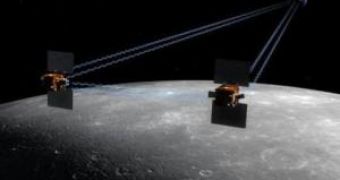The Moon is probably the strangest body in the solar system, as it has the largest size relative to that of the planet it orbits. Available theories about how it might have formed involve a possible catastrophic collision between an embrionary planet slightly larger than our own, or the original Earth if you will, and a body somewhere around the size of planet Mars.
Eventually, the remnant debris of the collision was pulled together by gravitational fields to form Earth and its big moon. In order to determine exactly what the origins of the Moon are, how it might have formed and its internal structure, NASA announced that it has selected a mission that will have the role of looking deep inside the Moon to reveal its history.
The Grail spacecraft which is scheduled to be operational by the year 2011, will be built by Lockheed Martin Space Systems and will most likely fly in a tandem configuration with its twin spacecraft to measure variations in the Moon's gravitational field. By correlating the gravitational field structure information with the X-ray image of the Moon's core, scientists will be able to study the past thermal activity of Earth's natural satellite.
Similar measuring techniques are being currently used by the Grace satellite to observe variations in the Earth gravitational field which will reveal the movement of mass under and on the surface of the planet such as the water cycle that moves massive amounts of ice at the poles, which influences the current circulation in the oceans.
Aside from the research made to determine the structure and the history of the Moon, NASA also decided that it will relaunch a manned mission on the surface of the Moon by the year 2020, thus spacecrafts similar to the Moon Orbiters sent to the Moon in the 1960s to study its surface and to identify possible landing sites and resources are needed. The Lunar Reconnaissance Orbiter or LRO in short, scheduled to launch next year, will evaluate the potential of the lunar resources or possible threats such as the level of radiation of the environment.
The Grail spacecraft has been selected by NASA's Discovery Program out of about 24 other missions proposed to be flown into space and provide bias on the internal structure of the Moon.

 14 DAY TRIAL //
14 DAY TRIAL //